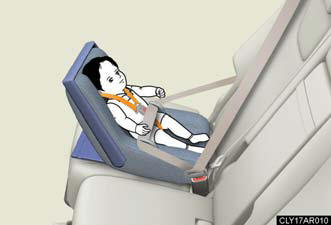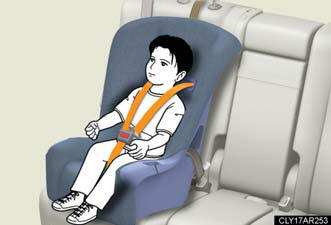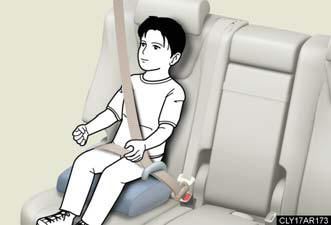Child restraint systems
A child restraint system for a small child or baby must itself be properly restrained on the seat with the lap portion of the lap/shoulder belt.
The laws of all 50 states of the U.S.A. and Canada now require the use of child restraint systems.
Points to remember
Studies have shown that installing a child restraint on a rear seat is much safer than installing one to the front passenger seat.
Choose a child restraint system that suits your vehicle and is appropriate to the age and size of the child.
For installation details, follow the instructions provided with the child restraint system.
General installation instructions are provided in this manual.
Types of child restraints
Child restraint systems are classified into the following 3 types according to the age and size of the child.
- Rear facing - Infant seat/convertible seat.

- Forward facing - Convertible seat

- Booster seat

Selecting an appropriate child restraint system
Use a child restraint system appropriate for the child until the child
becomes
large enough to properly wear the vehicle’s seat belt.
If the child is too large for a child restraint system, sit the child on a
rear seat and
use the vehicle's seat belt.
CAUTION:
Child restraint precautions
For effective protection in automobile accidents and sudden stops, a child
must
be properly restrained, using a seat belt or child restraint system depending on
the age and size of the child. Holding a child in your arms is not a substitute
for a
child restraint system. In an accident, the child can be crushed against the
windshield,
or between you and the vehicle's interior. This may cause death or serious
injury to the child in the event of a sudden stop or an accident.
Lexus strongly urges the use of a proper child restraint system that conforms
to
the size of the child, installed on the rear seat. According to accident
statistics, the
child is safer when properly restrained in the rear seat than in the front seat.
Never install a rear-facing child restraint system on the front passenger seat
even
if the “AIR BAG OFF” indicator light is illuminated. In the event of an
accident, the
force of the rapid inflation of the front passenger airbag can cause death or
serious
injury to the child if a rear-facing child restraint system is installed on the
front
passenger seat.
A forward-facing child restraint system may be installed on the front
passenger
seat only when it is unavoidable. A child restraint system that requires a top
tether
strap should not be used in the front passenger seat since there is no top
tether
strap anchor for the front passenger seat. Adjust the seatback as upright as
possible
and always move the seat as far back as possible even if the “AIR BAG OFF”
indicator light is illuminated, because the front passenger airbag could inflate
with
considerable speed and force. Otherwise, the child may be killed or seriously
injured.
Do not use the seat belt extender when installing a child restraint system on
the
front or rear passenger seat. If installing a child restraint system with the
seat belt
extender connected to the seat belt, the seat belt will not securely hold the
child
restraint system, which could cause death or serious injury to the child or
other
passengers in the event of a sudden stop, sudden swerve or accident.
Do not allow the child to lean his/her head or any part of his/her body
against the
door or the area of the seat, front and rear pillars or roof side rails from
which the
SRS side airbags or SRS curtain shield airbags deploy even if the child is
seated in
the child restraint system. It is dangerous if the side airbags and curtain
shield airbags
inflate, and the impact could cause death or serious injury to the child.
CAUTION:
Child restraint precautions
Make sure you have complied with all installation instructions provided by the
child
restraint manufacturer and that the system is properly secured. If it is not
secured
properly, it may cause death or serious injury to the child in the event of a
sudden
stop, sudden swerve or an accident.
Child restraint lock function belt precaution
Do not allow children to play with the child restraint lock function belt. If
the belt
becomes twisted around a child’s neck, it will not be possible to pull the belt
out
leading to choking or other serious injuries that could result in death.
If this occurs and the buckle cannot be unfastened, scissors should be used to
cut
the belt.
When the child restraint system is not in use Keep the child restraint system properly secured on the seat even if it is not in use.
Do not store the child restraint system unsecured in the passenger compartment.
If it is necessary to detach the child restraint system, remove it from the
vehicle or
store it securely in the luggage compartment. This will prevent it from injuring
passengers in the event of a sudden stop, sudden swerve or accident.
See also:
Driving the vehicle
The following procedures should be observed to ensure safe driving.
Driving
With the brake pedal depressed, shift the shift lever to D.
Release the parking brake.
Gradually release the brake peda ...
Engine compartment
1. Brake fluid reservoir.
2. Engine oil filler cap.
3. Engine oil level dipstick.
4. Power control unit coolant
reservoir.
5. Fuse boxes.
6. Engine coolant reservoir.
7. Radiator.
8. Conden ...
Kinetic Dynamic Suspension System (KDSS)
KDSS is standard on the Lexus GX 460, and enhanced for 2010 with steering and
yaw sensors. By adjusting roll resistance provided by the front and rear
stabilizer bars, KDSS can reduce maximum body ...
